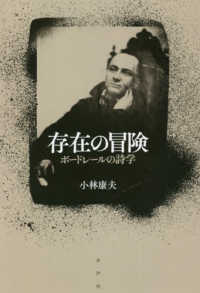- ホーム
- > 洋書
- > 英文書
- > History / World
Full Description
The "World Temple" Pura Ulun Danu Batur embodies the still active volcano and its lake. It constitutes the linchpin between the visible and invisible world that has been a contested centre of power by rulers for centuries. The study challenges the claim of the aboriginal-egalitarian Mountain Balinese. Instead, it shows that the temple is the result of colonizing thrusts into the highlands by lowland courts of East-Javanese origin since the 15th century. The pre-existing Buddhist monastery and its counterpart, a king residing near-by, as well as their temples became effaced, villages were merged and Siwaite teachings introduced. The book tells the thrilling story of this fundamental transformation as evidenced in the temple, a UNESCO World Heritage Site today.
Contents
Acknowledgments
List of Illustrations and Tables
1 Introduction
1 Bali's Past and One of Its Blind Spots: Buddhism
2 The Balinese State or the Impact of Western Theories
3 Pura Ulun Danu Batur as a State Temple
4 Unravelling Threads of History
5 The Organization of the Book
2 Living beneath the Batur Volcano
1 Fire-Spitting Mountain and Shaking Ground
2 An Old Village Map and Its Clues
3 Concluding Comment
3 The Batur Temple Complex and Differences Within
1 Pura Ulun Danu Batur
2 The Temples of Desa Pakraman
3 Pura Dang Kahyangan and Other Shrines of Batur Village Deities
4 Concluding Comment
4 The Social Organization of the Batur Temple
1 Village Association and bale agung as the Organizational Centre
2 The High Priests of Pura Ulun Danu
3 The Office of perbekel/petinggi
4 Desa Pakraman and High Priests: Acknowledging Ritual Leadership
5 Concluding Comment
5 Relics of a Monastic-Political Domain and Its Demise
1 Pura Jati Today
2 Pura Jati's Origin: the Blackened Stump and warga Kayu Slem
3 Concluding Comment
6 Centre and Periphery: the Ritual Organization of a Sacro-Political Domain
1 From the Periphery to the Centre: the Pilgrims' Tributes
2 From the Centre to the Periphery: the Visits of Batur's Deities
3 Concluding Comment
7 Resistance, Compliance and the Introduction of Indirect Rule
1 Vertical Relationships between Court and Villages
2 Beyond Village Egalitarianism: Hierarchical Offices
3 Concluding Comment
8 Reshaping Polities and Sacred Sites: Infiltrations and Relocations
1 The Annihilation of Powerful Sites and Their Rulers
2 Baturenggong's Regulation Addressed to Sinarata
3 Relocations and Transformations
4 Pura Dalem: the Commemoration of Vanished Villages and Offices
5 Concluding Comment
9 Transfer and Merging of Fertility Rituals of Former Autonomous Temples
1 Escaping Reorganization: the Office of Virgin Priestesses, balyan
2 The Consolidation of Fertility Rituals in Pura Ulun Danu Batur
3 Concluding Comment
10 The State Temple as a Political and Economic Hub
1 Temple Economy: the Temple's pasyan, the Ruler's kaule
2 In the Steps of Former Rulers, and the Money Economy
3 Concluding Comment
11 Exploring the Site and Rulership of a Pre-Majapahit Court
1 Pura Dalem Balingkang: a Court Turned into a Temple
2 Harbours, Trade and Kings
3 The Reception of Merchants, kaule and Priests
4 Concluding Comment
12 Ritual Networks and Beyond: Segments of negara and Their Integration
1 Rulers, Regional Networks and the Recruitment of Troops
2 Concluding Comment
Conclusion
Afterword
References
Appendix
1 Maps of Temple Layouts and Tables
2 Usana Bali (Rajapurana Batur)
3 Usana Bali (Rajapurana Batur) §24b1-26a 1
4 Titiswara






